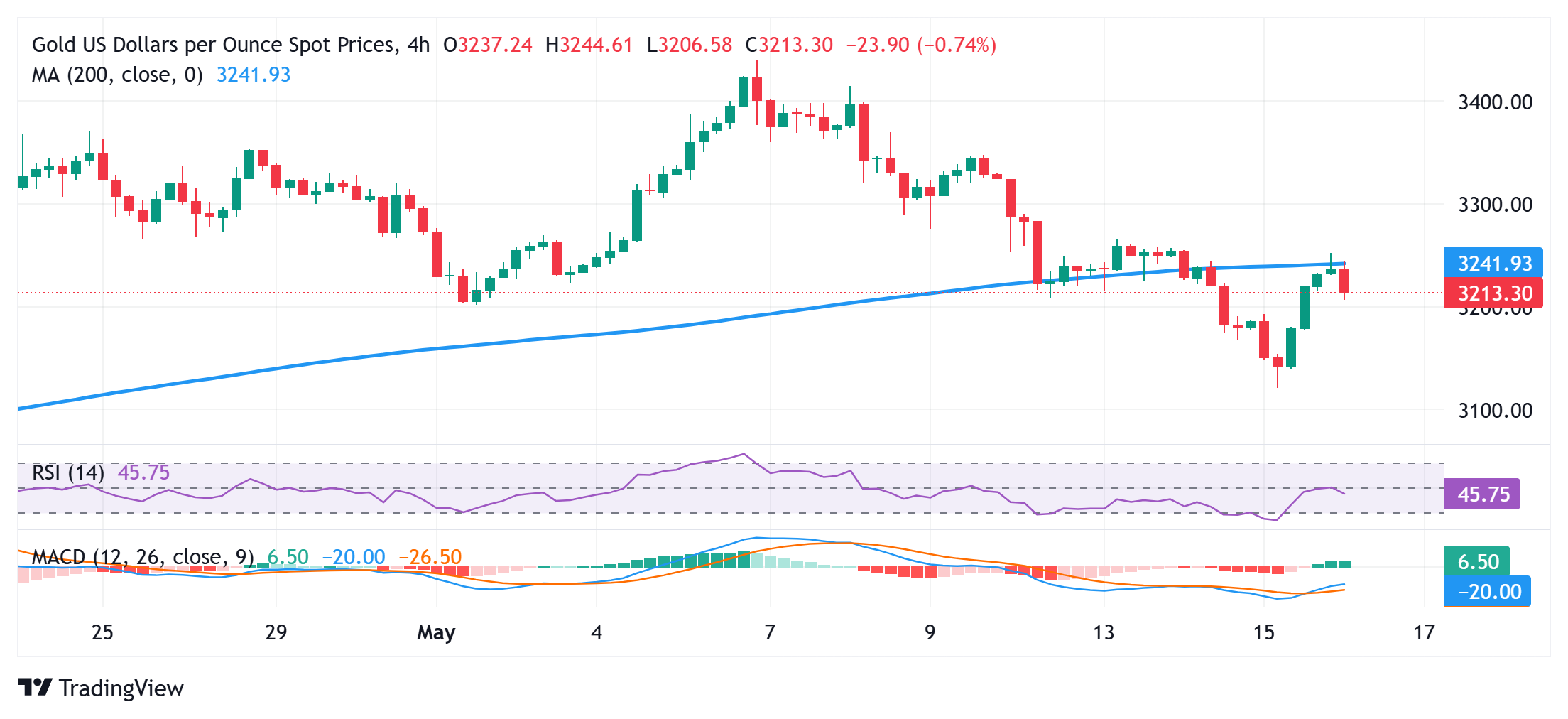-
Gold prices come under fresh selling pressure, trimming part of Thursday's recovery gains.
-
Optimism surrounding the US-China trade deal continues to weigh on the safe-haven commodity.
-
Expectations of a Fed rate cut keep the USD subdued, helping to contain losses amid ongoing geopolitical risks.
Gold price (XAU/USD) continues its steady intraday decline during the first half of the European session on Friday, sliding back below the $3,200 mark in the last hour. Renewed optimism over the US-China trade truce weakens demand for traditional safe-haven assets, preventing gold from building on the previous day’s strong recovery from the $3,120 area, marking a more than one-month low.
Thursday’s weaker US macroeconomic data reinforced expectations for additional Fed interest rate cuts and pushed US Treasury bond yields lower. Despite keeping the US Dollar (USD) on the defensive for the second consecutive day, this does not provide support to the non-yielding gold price. Moreover, ongoing geopolitical risks have minimal impact on the prevailing intraday bearish sentiment surrounding the XAU/USD pair.
Daily Digest Market Movers: Gold Price Bears Hold Firm Amid Fading Safe-Haven Demand
-
Gold prices remain under pressure as optimism over the US-China trade deal reduces the demand for traditional safe-haven assets.
-
The two economic giants have agreed to significantly lower tariffs and initiated a 90-day pause to finalize a broader agreement, signaling a de-escalation in their prolonged trade conflict.
-
Additionally, US President Trump highlighted ongoing trade negotiations with India, Japan, and South Korea, adding to the positive risk sentiment.
-
Diplomatic efforts continue as Russia and Ukraine, along with a US delegation, meet in Istanbul, Turkey, for their first direct peace talks in three years. However, the absence of Russian President Vladimir Putin dampens hopes for a breakthrough to end the prolonged conflict.
-
Meanwhile, Israel's military has intensified its operations in the Gaza Strip since Thursday morning, leading to the deaths of at least 143 Palestinians. The escalation keeps geopolitical risks relevant, which, coupled with the lack of significant US Dollar buying interest, may offer some support to gold prices.
-
Gold prices find some underlying support as softer US economic data continues to fuel expectations of more Federal Reserve rate cuts.
-
On Thursday, the US Producer Price Index (PPI) for final demand dropped 0.5% in April, marking the first monthly decline since 2023.
-
Earlier, the US Consumer Price Index (CPI) released on Tuesday showed the lowest annual increase since February 2021, indicating signs of easing inflationary pressures.
-
Both reports pushed US Treasury bond yields lower, weakening the US Dollar for a second consecutive day and marginally supporting the non-yielding yellow metal.
-
In another sign of potential economic sluggishness, the US Department of Commerce reported that Retail Sales grew by just 0.1% in April, following a 1.7% upward revision for the previous month.
-
This minimal growth hints at the possibility of several quarters of economic stagnation, reinforcing the market's expectation of dovish Fed policies moving forward.
-
Despite ongoing geopolitical risks and a weaker dollar, the positive sentiment surrounding the US-China trade deal and better-than-expected progress in international trade negotiations continue to limit the upside for gold prices.
-
Investors should monitor upcoming economic data and geopolitical developments for potential triggers that might sway the current bearish trend in the XAU/USD pair.
Gold Price Outlook: Potential Downside Acceleration and Key Technical Levels

Gold price could see an accelerated intraday decline if the $3,178-$3,177 support zone is decisively breached. This breakdown would likely intensify bearish momentum, increasing the risk of a deeper slide.
Following a recovery from a one-month low, the bullish move faltered near the 200-period Simple Moving Average (SMA) on the 4-hour chart, positioned around the $3,252-$3,255 zone. Despite this rebound, negative oscillators on the daily chart suggest caution, as further confirmation is needed before concluding that the recent downtrend in XAU/USD has ended. Waiting for strong follow-through buying is recommended before placing new bullish positions.
If gold weakens below the $3,200 mark, initial support could emerge around the $3,178-$3,177 region. Further selling pressure might push the price towards the overnight swing low near $3,120. Should the decline persist, the next downside targets could be around $3,100, with subsequent support near $3,060.
On the other hand, the $3,252-$3,255 zone may continue to act as an immediate resistance. Sustained buying above this level could trigger a short-covering rally, helping the gold price reclaim the $3,300 mark. Clearing this pivotal resistance decisively would negate the near-term bearish outlook and shift sentiment towards bullish traders, opening the path for potential gains.





